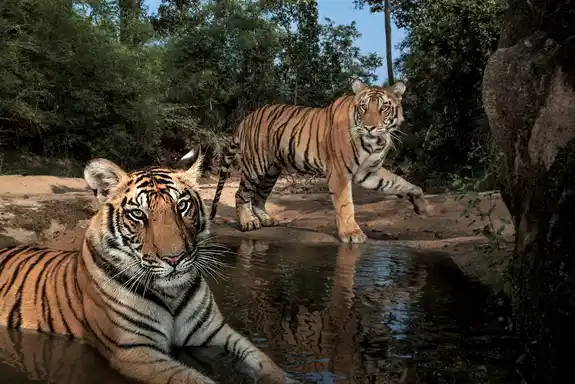#1: Bengal Tiger
Out of all the animals in India, the Bengal tiger is probably the most famous. They are the largest cat species in the world and the most numerous subspecies of tiger in the wild today. These big cats are capable of killing animals over twice their size and have powerful paws and jaws which helps them catch their prey.
Did you know: Every tiger in the world is unique; no two tigers have the same stripes just like a human fingerprint! Unlike other big cats, tigers love water so can often be found around waterholes and rivers. One of the best places to see tigers in the wild in India is Kanha National Park, a true wilderness with rolling grasslands and winding streams making it a picturesque location to enjoy tiger tracking.
When to go: Travel between March–April for the best tiger sightings. This is the end of the dry season so tigers are easier to spot, but temperatures are high!
#2: Sloth Bear
Much smaller than Disney’s Jungle Book portrayed, sloth bears normally stand at around 5 – 6 foot in height. These fluffy, somewhat lanky bears are generally solitary animals residing in the forests of the Indian subcontinent.
Did you know: Sloth bears are nocturnal mainly foraging for termites and fruit at night. Sloth bears are considered vulnerable by the IUCN. Their numbers have decreased due habitat loss and human poaching thanks to their tameable nature. The best park in India to see sloth bears is Satpura National Park.
When to go: The best time to see sloth bears in India is the tail end of the dry season, luckily the same time as tigers!
#3: One-Horned Rhino
Similar to their African counterparts, Indian rhinos have thick grey skin and a large stature, but notably this subspecies only has one horn rather than two.
Did you know: Rhinos horns are made of keratin, the same protein as human hair and nails. The habitat of Indian rhinoceroses is limited to one particular area of India: the Indo-Gangetic Plain so sightings are likely if you know where to go. Head to Kaziranga Wildlife Sanctuary for the best sightings; it is home to two thirds of the world’s population of one-horned rhinos. Although their conservation status is vulnerable, numbers have increased dramatically over the past 100 years, from just 12 individuals in Kaziranga in 1,908, to 1,855 today. This is a fantastic conservation success story!
When to go: One-horned rhinos can be seen year-round in Kaziranga Wildlife Sanctuary keep your eyes peeled and camera at the ready!
#4: Asiatic Leopard
Asiatic leopards are very elusive, solitary creatures seen amongst rocky outcrops in India’s national parks. Leopards are stealthy hunters found mainly at dusk and dawn seeking out prey such as deer and fowl.
Did you know: Indian leopards have larger black rosettes than African leopards. Populations are relatively high in India with between 12,000 and 14,000 leopards thought to live in the wild. The best location for leopards in India is Jawai. In this area it is even thought that leopards are the sacred guardians of the local ancient temples!
When to go: October – March is the best time to visit Jawai to see Asiatic leopards.















